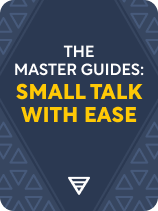

This article is an excerpt from the Shortform book guide to "The Master Guides: Small Talk With Ease" by Shortform. Shortform has the world's best summaries and analyses of books you should be reading.
Like this article? Sign up for a free trial here.
Why should you pay attention to your body language if you want to make a great first impression? Do you give closed body language cues without even knowing it?
Your body language determines people’s first impressions of you. So, it’s important to understand the various body language cues and learn to leverage them if you want people to find you open and welcoming.
Keep reading to learn how to exhibit approachable body language around others.
Making a Good First Impression Through Approachable Body Language
Once you arrive at a social event, focus on making a great first impression. This involves sending approachable body language cues to appear welcoming and make others want to engage with you.
According to Leil Lowndes (How to Talk to Anyone), people rely on body language to form an instinctive impression of everyone they come across within the first few seconds of seeing them. This means that, before you get a chance to utter your first words, people have already made assumptions about your personality, your feelings, your confidence levels, and your social or professional status. Most importantly, they’ve already decided whether you’re the type of person that they want to spend time with.
Additionally, award-winning public speaker Peter D. Andrei (How Highly Effective People Speak) explains, the first impressions people have about you influence how they continue to think about you. He says that the assumptions others initially make about you influence their long-term relationship with you due to a phenomenon called the halo effect: the tendency for people to base their overall impression of a person on one observed quality.
The halo effect is the result of a combination of other cognitive biases, including the primacy effect, attribution substitution, and confirmation bias. When you notice an initial positive quality in a person (primacy effect), you’ll attribute a host of other positive qualities to that person (attribute substitution), and then see small signs that point to those positive qualities as confirmation of your beliefs (confirmation bias).
In other words, if your body language initially makes others feel as if you like them, they’ll continue to feel that you like them, regardless of what you say or do.
Distinguish Between Open and Closed Body Language Cues
Now that you understand how important body language is in making a positive first impression, here’s some practical advice for using body language to make yourself appear more approachable and likable.
Adopt Open Body Language Cues
According to body language experts Allan and Barbara Pease (The Definitive Book of Body Language), people who are friendly and approachable tend to hold a relaxed and open posture, raise their eyebrows to signal that they’re happy to engage in conversation, make eye contact, and smile.
Lowndes clarifies that people interpret good posture as a welcoming signal because it implies that you’re proud and confident and have nothing to hide. They’ll assume that you’re an accomplished person who deserves their attention. She adds that people interpret a relaxed and open stance as a sign of an honest and welcoming personality because it signals that you’re calm, unafraid of appearing vulnerable (because you have nothing to hide), and approachable.
To come across as calm, self-assured, and trustworthy, she suggests that you practice keeping your arms loosely by your sides with your palms and wrists facing upwards. If you’re approached by people you want to talk to, turn your body totally toward them to show them they’ve got your full attention—this implies that you’re happy to be in their company and puts them at ease.
Avoid Closed Body Language Cues
According to The Definitive Book of Body Language by Allan and Barbara Pease, people who don’t want to be approached tend to hold a stiff or guarded posture (for example slouching with their arms folded), avoid eye contact, and frown.
Lowndes explains that people interpret poor posture as an unwelcoming signal. Trying to minimize your physical presence by slumping implies that you’re insecure or ashamed and don’t want to be approached. Further, she says that people interpret fidgeting and guarded movements as insincerity because they make you look suspicious and defensive:
- Fidgety movements, such as shuffling your feet or touching your face, come across as signs of discomfort, tension, or distraction.
- Guarded movements, such as folding your arms or clutching something in front of your body, also convey discomfort. Additionally, they give the impression that you’re placing barriers between yourself and other people.

———End of Preview———
Like what you just read? Read the rest of the world's best book summary and analysis of Shortform's "The Master Guides: Small Talk With Ease" at Shortform.
Here's what you'll find in our full The Master Guides: Small Talk With Ease summary:
- How to confidently approach and engage in conversations with new people
- Suggestions and techniques from a range of authors and experts
- Techniques to appear more approachable—without saying a word






